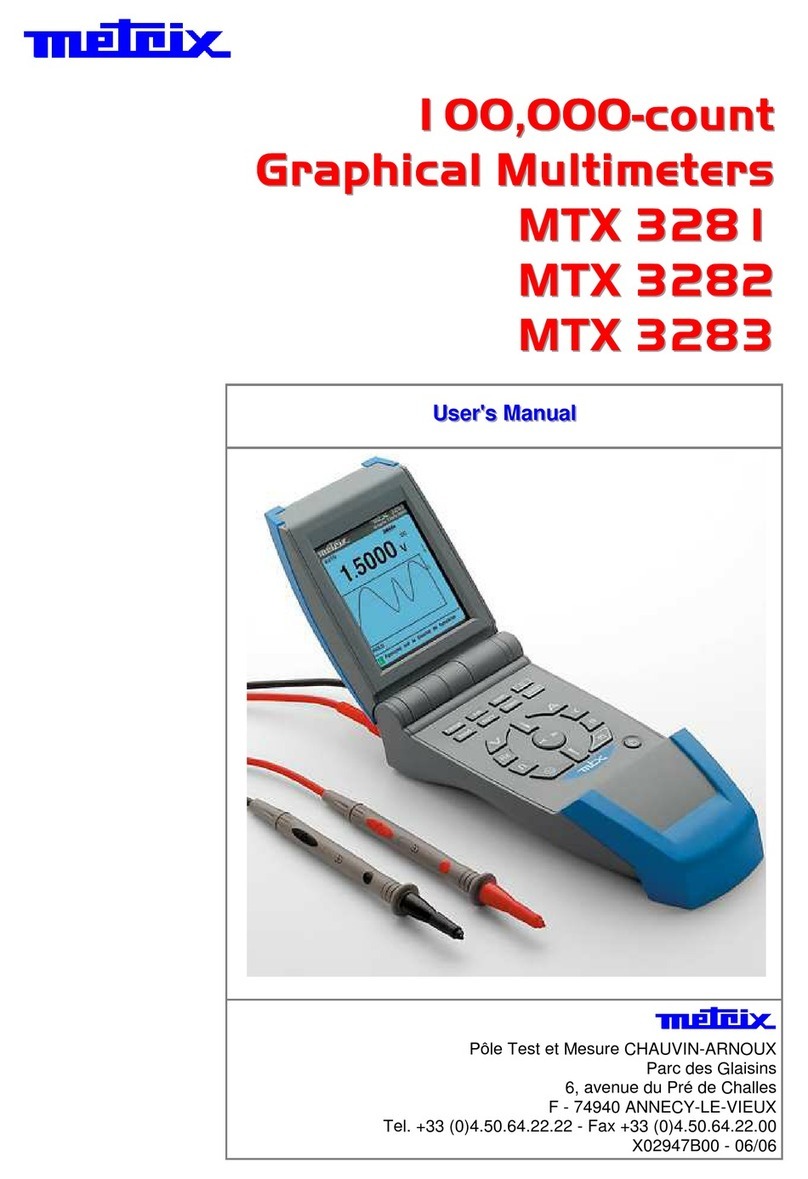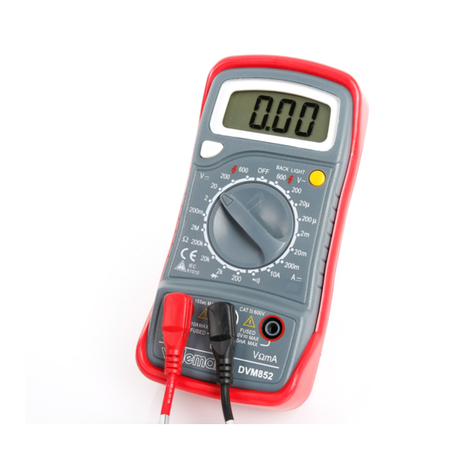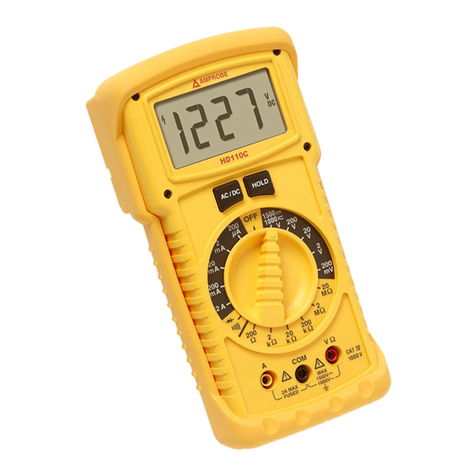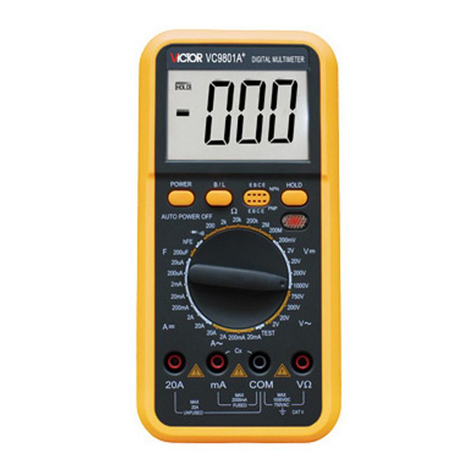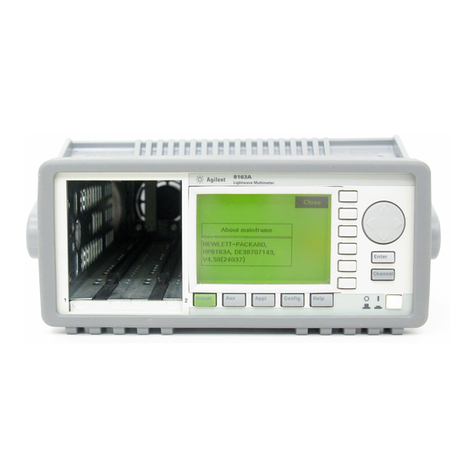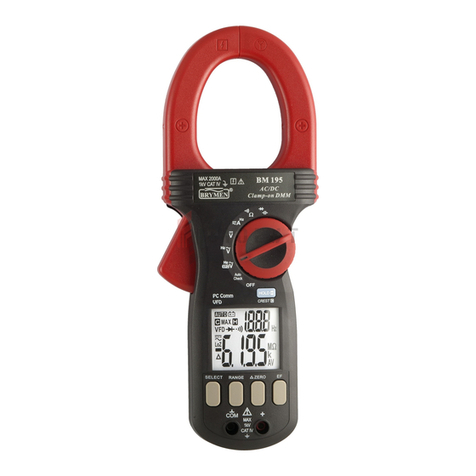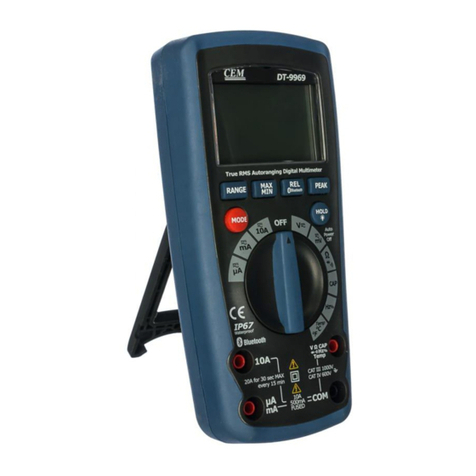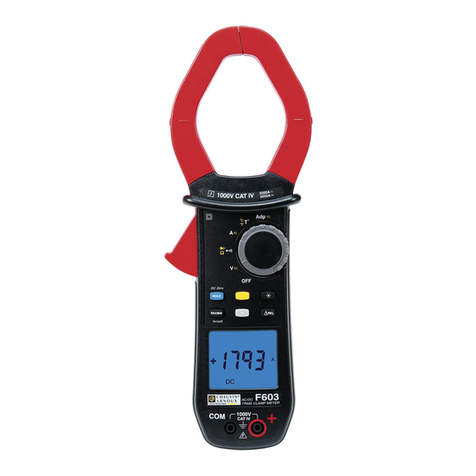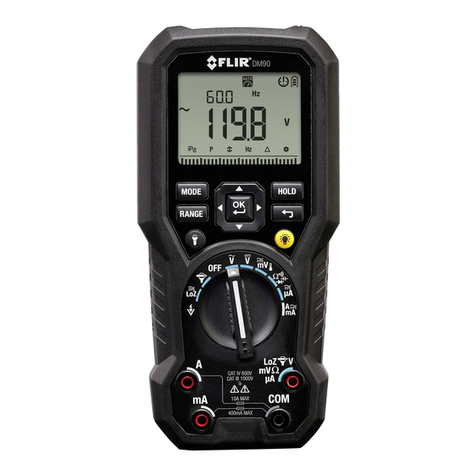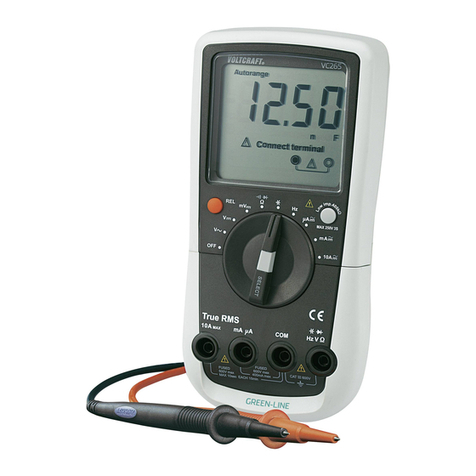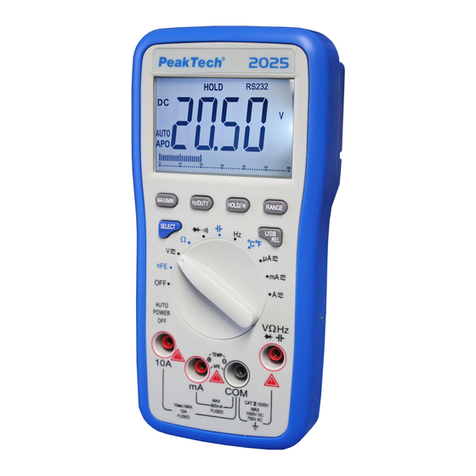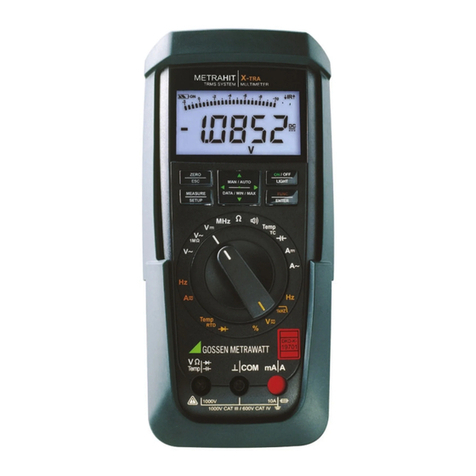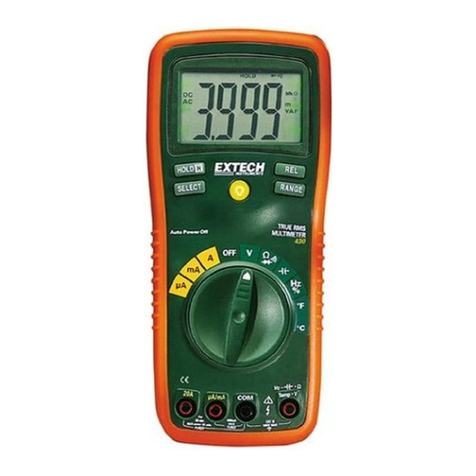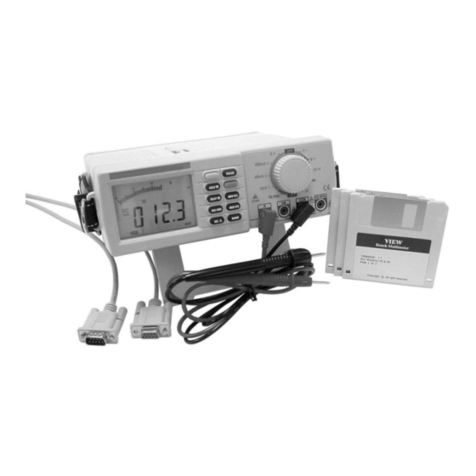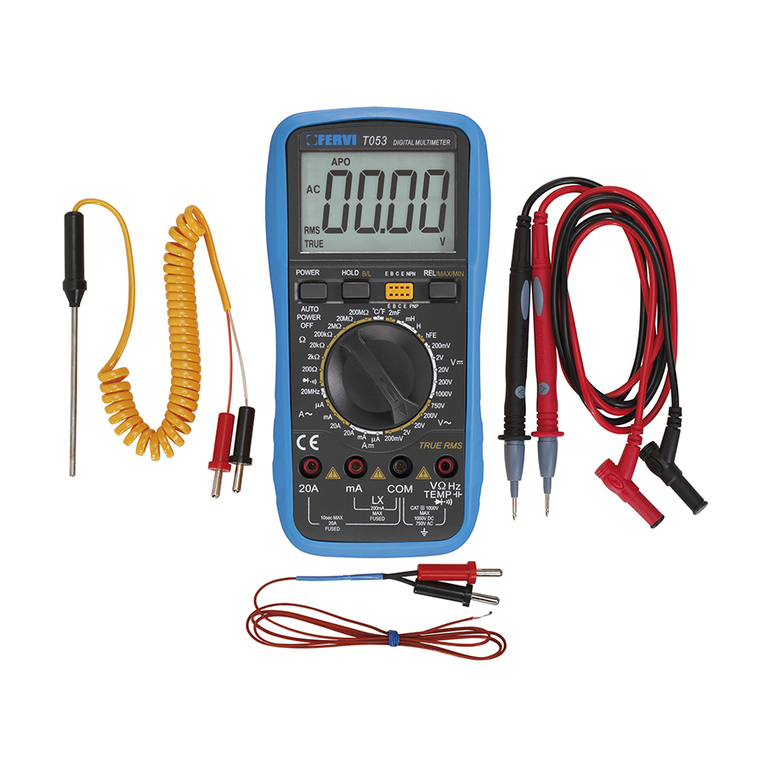Metrix MX 24B User manual

Copyright © X01877A00 -Ed. 4 -02/04
MX 24B
MULTIMETRE NUMERIQUE
DIGITAL MULTIMETER
DIGITAL MULTIMETER
MULTIMETRO DIGITALE
MULTIMETRO DIGITAL
Notice de fonctionnement page 1 Chapitre
User's manual page 14 Chapter
Bedienungsanleitung Seite 28 Kapitel
Libretto d'istruzioni pagina 42 Capitolo
Manual de instrucciones página 56 Capítulo
I
II
IV
III
V

Multimètre digital portable 5000 points, avec entrée courant
5
6
18
17
16
15
14
13
12
11
7
1234
19
20
21
22
8
9
10
500mA
MX 24B
500mADC

Chapter II
5000-count portable digital multimeter, with current input
14
USER’S MANUAL
CONTENTS
1. GENERAL INSTRUCTIONS....................................................................................................................15
1.1. Precautions and safety measures....................................................................................................15
1.1.1. Preliminary....................................................................................................................................15
1.1.2. During use....................................................................................................................................15
1.1.3. Symbols........................................................................................................................................16
1.1.4. Instructions...................................................................................................................................16
1.2. Protection devices............................................................................................................................16
1.3. Safety devices..................................................................................................................................17
1.4. Warranty...........................................................................................................................................17
1.5. Maintenance and metrological verification.......................................................................................17
1.6. Unpacking -Repackaging................................................................................................................17
2. DESCRIPTION.........................................................................................................................................18
2.1. Selector switch.................................................................................................................................18
2.2. Keypad .............................................................................................................................................18
2.3. Display..............................................................................................................................................18
2.4. Power supply....................................................................................................................................18
2.5. Input terminals..................................................................................................................................18
3. GETTING STARTED ...............................................................................................................................19
3.1. Connecting the test leads.................................................................................................................19
3.2. Switching on the instrument.............................................................................................................19
3.3. Switching off the instrument.............................................................................................................19
3.4. Special configuration........................................................................................................................19
3.5. Multimeter maintenance...................................................................................................................19
3.5.1. Fuse self-test................................................................................................................................19
3.5.2. Battery self-test.............................................................................................................................20
3.5.3. Replacing the battery or fuses......................................................................................................20
3.5.4. Cleaning .......................................................................................................................................20
3.5.5. Storage.........................................................................................................................................20
4. FUNCTIONAL DESCRIPTION ................................................................................................................21
4.1. RANGE / AC+DC key.......................................................................................................................21
4.1.1. ADPDC / ADPAC+DC Position ....................................................................................................21
4.1.2 500 mADC / 500 mAAC+DC Position..........................................................................................21
4.1.3. 10 ADC / 10 AAC+DC Position ....................................................................................................22
4.2. MIN/MAX key....................................................................................................................................22
4.3. MEM / AUTO MEM key...................................................................................................................22
4.4 key..........................................................................................................................................22
5. TECHNICAL SPECIFICATIONS..............................................................................................................23
5.1. General.............................................................................................................................................23
5.2. Characteristics..................................................................................................................................23
5.2.1. DC voltages..................................................................................................................................23
5.2.2. AC voltages (AC and AC+DC) .....................................................................................................23
5.2.3. DC current....................................................................................................................................24
5.2.4. AC currents (AC+DC)...................................................................................................................24
5.2.5. Resistance / Continuity test..........................................................................................................24
5.2.6. Capacitance..................................................................................................................................25
5.2.7. Diode threshold voltage measurement.........................................................................................25
5.2.8. Frequencies..................................................................................................................................25
5.2.9. Safety ...........................................................................................................................................25
5.2.10. General information..................................................................................................................26
5.2.11. Environment .............................................................................................................................26
5.2.12. EMC..........................................................................................................................................26
5.3. Accessories......................................................................................................................................27
5.3.1. Supplied with the multimeter ........................................................................................................27
5.3.2. Optional........................................................................................................................................27

Chapter II
5000-count portable digital multimeter, with current input 15
1. GENERAL INSTRUCTIONS
You have just acquired a portable digital multimeter and we thank you for your confidence.
This instrument complies with the specification of IEC 61010-1 + A1 + A2, 1995, con-
cerning safety requirements for electronic measuring apparatus. To get the best service
from this instrument, read carefully this user's manual and respect the detailed safety
precautions.
The contents of this manual must not be reproduced in any form whatsoever without our
consent.
1.1. Precautions and safety measures
1.1.1. Preliminary
-This device can be used for measurements on category ΙΙΙ installations, for voltages
never exceeding 600 V (AC or DC) relative to the earth.
-Definition of overvoltage categories (cf. publication IEC 664-1) :
CAT I: The circuits of CAT I are protected by measures limiting transient
overvoltages to appropriate low level.
Example : protected electronic circuits
CAT II : The circuits of CAT II are power supply circuits of appliances or portable
equipment with transient overvoltages of an average level.
Example : appliances and portable equipment
CAT III : The circuits of CAT III are power supply circuits of power equipment with
important transient overvoltages.
Example : fixed installation or industrial equipment
CAT IV :The circuits of CAT IV may comprise very important transient
overvoltages.
Example : primary supply level
∗When using this multimeter, the user must observe all normal safety rules
concerning:
-protection against the dangers of electric current.
-protection of the multimeter against misuse.
∗For your own safety, only use the measuring probes which have been delivered with
the instrument : they conform to the IEC 61010-1 + A1 + A2, 1995 safety standard.
Before use, check that they are in good working condition.
1.1.2. During use
∗Test equipment risk assessment : Users of this equipment and or their employers
are reminded that Health and Safety Legislation require them to carry out a valid
risk assessment of all electrical work so as to identify potential sources of electrical
danger and risk of electrical injury such as from inadvertent short circuits. Where
the assessment show that the risk is significant then the use of fused test leads
constructed in accordance with the HSE guidance note GS38 "Electrical Test
Equipment for use by Electricians" should be used.
∗Never exceed the protection limit values indicated in the specifications for each type
of measurement.

Chapter II
5000-count portable digital multimeter, with current input
16
∗When the multimeter is linked to measurement circuits, do not touch unused
terminals.
∗When the scale of the value to be measured is unknown, check that the scale initially
set on the multimeter is the highest possible or, wherever possible, choose the
autoranging mode.
∗Before changing functions, disconnect the test leads from the circuit under test.
∗In TV repair work, or when carrying out measurements on power switching circuits,
remember that high amplitude voltage pulses at the test points can damage the
multimeter. Use of a TV filter will attenuate any such pulses.
∗Never perform resistance or continuty measurements on live circuits.
1.1.3. Symbols
Symbols used in this manual and on the instrument :
CAUTION : Refer to the instruction manual.
Incorrect use may result in damage to the device or its components.
DANGER : High voltage, risk of electric shock.
Earth
1.1.4. Instructions
∗Before opening the instrument, always disconnect from all sources of electric
current and make sure not to be loaded with static electricity, which may destroy
internal components.
∗Fuses must be replaced with fuses of the same rating and type.
∗Any adjustment, maintenance or repair work carried out on the multimeter while it
is live should be carried out only by appropriately qualified personnel, after
having taken into account the instructions in this present manual.
A "qualified person" is one who is familiar with the installation, construction and
operation of the equipment and the hazards involved. He is trained and
authorized to energize, de-energize circuits and equipment in accordance with
established practices.
∗When the instrument is open, remember that some internal capacitors can retain
a dangerous potential even after the instrument is powered down.
∗If any faults or abnormalities are observed, take the instrument out of service and
ensure that it cannot be used until it has been checked out.
∗ It is recommended to remove the battery from the instrument if not used.
1.2. Protection devices
This instrument is fitted with various protection devices :
∗Varistor protection for limiting transients of over 1100 V at the VΩterminal,
particularly 6 kV pulse streams as defined in French standard IEEE 587.
∗A PTC (positive temperature coefficient) resistor protects against permanent
overvoltages of up to 600 V during resistance, capacitance, continuity and diode
test measurements. This protection is reset automatically after overload.

Chapter II
5000-count portable digital multimeter, with current input 17
∗Two HBC fuses provide protection up to 600 V during measurements of intensity
type.
∗An IP protection rating of 40.
1.3. Safety devices
∗The battery unit cannot be accessed without first disconnecting the measuring
leads.
∗When measuring voltages above 24 V, the sign blinks on the display.
∗When measuring voltages above 10 A, the sign blinks on the display and an
intermittent audible signal warns the user.
∗If the maximum range is repeatedly exceeded, an intermittent audible signal warns
the user in VLOW Z, VAC+DC, VDC,ADPDC, ADPAC+DC, 500 mADC, 500 mAAC+DC,
10 ADC, 10 AAC+DC functions.
1.4. Warranty
This equipment is warranted against any defects of manufacture or materials according to
the general conditions of sale.
During the warranty period (3 years), defective parts will be replaced, the manufacturer
reserving the right to repair or replace the product. In the event of the equipment being
returned to the distributor or to a local agency, carriage to the centre shall be payable by
the customer. The warranty does not cover the following :
1. Repairs necessitated by misuse of the equipment or use in association with
incompatible equipment.
2. Modification of the equipment or any related software without the explicit
authorization of the manufacturer.
3. Repairs necessitated by attempts to repair or maintain the product made by a person
not approved by the manufacturer.
4. Adaptation to a specific application not provided for in the specifications of the
equipment or the user manual.
5. Damage after a drop, a shock or flooding.
1.5. Maintenance and metrological verification
Return your instrument to your distributor for any work to be done within or outside the
guarantee.
1.6. Unpacking -Repackaging
This equipment has been fully checked out mechanically and electrically before shipping.
All precautions have been taken to ensure that the instrument arrives at its destination
undamaged. However, it is advisable to carry out a rapid check for damage sustained in
shipping. If there is any evidence of damage, make this known immediately to the
shipper.
GShould you need to return the multimeter, preferably use the original packaging
and indicate the reasons as clearly as possible on an accompanying note.
FOur products are patented in FRANCE and internationally and the logotypes are
registered. We reserve the right to modify specifications and prices as required by
technological improvements.

Chapter II
5000-count portable digital multimeter, with current input
18
2. DESCRIPTION
This compact multimeter is a self-contained with an appropriate mechanical construction,
enables hand-held version, with a protective elastomer case.
It is designed for a high degree of user safety, maximum protection and unrivalled
performance.
2.1. Selector switch
This multimeter is a standalone, hand-held professional measuring instrument, capable of
measuring the following quantities (accessed by the twelve-position rotary selector switch) :
∗AC voltages with AC (or RMS) capacitive coupling (Input impedance : 500 kΩ)
∗AC voltages with AC+DC (or TRMS) direct coupling
∗DC voltages
∗DC / AC+DC voltages, range 500 mV
∗AC currents with AC+DC (or TRMS) direct coupling
∗DC currents
∗resistance values
∗continuity (with beeper)
∗capacitance
∗diode threshold voltage
∗frequencies
2.2. Keypad
A four-key keypad lets you :
∗select the autoranging mode (RANGE / AC+DC key)
∗store a value (MEM key)
∗activate the MIN-MAX-AVG detection mode (MIN/MAX key)
∗select a function derived from the main function, or switch on the multimeter again
after it has been shut down automatically (RANGE / AC+DC key)
∗activate back lighting of the display unit ( key)
2.3. Display
This multimeter display provides :
∗perform 5 000-count measurements (50 000-count Hz-measurement),
∗function indicator (V, A, AC+DC, F, Hz, , Ω, , AUTO, MEM, MIN, MAX, AVG)
and multiplicator (n, µ, m, k, M),
∗battery discharged indicator BAT : approximately 12 hours of operation,
∗clearly legible figures (11 mm high),
∗an analogue readout of the parameter being measured through a 34-segment
bargraph.
Display back light when required in poor lighting conditions. automatic switch-off.
2.4. Power supply
This multimeter is powered by a standard 9V battery (6LF22) which provides
approximately 500 hours of operation (on function VDC).
2.5. Input terminals
Measurements are performed using two measuring leads supplied with the instrument
connected to input terminals 1, 2, 3 and 4, as indicated in section 3.1.

Chapter II
5000-count portable digital multimeter, with current input 19
3. GETTING STARTED
3.1. Connecting the test leads
Connect the black lead to the COM socket (for all measurements). Depending on the
position of the selector switch, connect the red lead as follows:
Rotary selector switch position Input terminal
VLOW Z, VAC+DC, VDC,ADPDC (ADPAC+DC), FREQ, , Ω, , V Ω
500 mADC (500 mAAC+DC)500 mA
10 ADC (10 AAC+DC)10 A
3.2. Switching on the instrument
The selector switch is on the OFF position.
Turn the selector switch to the required function.
All segments of the display come on for a few seconds. The instrument is then ready for
measurements.
3.3. Switching off the instrument
The instrument can be switched off manually by returning the selector switch to the OFF
position, or automatically after approximately half an hour if no key is pressed or the
switch is not operated.
FNote For user safety, automatic shutdown is also disabled when a measured
magnitude (voltage/current) present at the input exceeds dangerous level
(indicator displayed).
3.4. Special configuration
To adapt the configuration of the instrument to the measurement environment, the user
can choose 50 Hz or 60 Hz rejection :
Switch on with the rotary switch while holding down the MEM key. The selection is
reversed from the last configuration, is displayed for two seconds and remains backed
up in non-volatile memory.
3.5. Multimeter maintenance
3.5.1. Fuse self-test
This check can be carried out with the multimeter in use without opening up the casing.
-0.63 A fuse (F1) : set the rotary switch to the position and short-circuit the 500 mA
and VΩsockets. The display should read approx. 0.001 V. If the digital display indicates
an overflow « .OL ». The fuse is blown.
-10 A fuse (F2) : set the rotary switch to the position and short-circuit the COM and V
Ωsockets. The display should read approx. 0.001 V. If the digital display indicates an
overflow « .OL ». The fuse is blown.

Chapter II
5000-count portable digital multimeter, with current input
20
3.5.2. Battery self-test
When the “BAT” indication appears on the display, the instrument still has approximately
12 hours of operation, but specifications can no longer be guaranteed.
Replace the battery.
Before changing the used battery, please ensure that the “Bat” symbol
lights up, including when there is no signal at the multimeter input.
3.5.3. Replacing the battery or fuses
GCaution ! Disconnect test leads from any circuit under test, turn the meter off
and remove test leads from the input terminals .
Use the following procedure:
1 -Disconnect test leads from any inputs terminals
2 -Using a appropriate tool, make slide the case bottom of the instrument
3 -Replace the battery or fuse (respect the value and the type).
4 -Replace the immovable part.
GFitting the fuses :
Those fuses are correctly fitted ; those ones are not.
3.5.4. Cleaning
Clean the instrument using a damp cloth and soap. Never use abrasive or solvents.
3.5.5. Storage
To guarantee the measurement accuracy, after a long period storage in extreme
environment conditions, wait enough time for the instrument to acclimatise to the
working environment conditions (see environment specifications).
Fuses must be replaced
by fuses of the same
rating and type.
6LF22
9 V BATTERY
F1 0.63 A HBC18 kA / 600 V F2 10 A HBC 50 kA / 600 V

Chapter II
5000-count portable digital multimeter, with current input 21
4. FUNCTIONAL DESCRIPTION
4.1. RANGE / AC+DC key
The RANGE key is operative in following positions of the selector switch :
VLOW Z, VAC+DC, VDC, Ω, .
This key makes it possible :
•In AUTO (Autoraging) mode to switch to MANUAL mode (short press).
•In MANUAL mode, to select the next range (short press) or return to AUTO mode
(long press), the AUTO sign appears on the display.
This can be used to switch on the multimeter again after an automatic shutdown. It can
also be used to access secondary functions associated with the selector switch positions :
mode AC+DC.
The flowcharts below define these various functions.
4.1.1. ADPDC / ADPAC+DC Position
This function is adapted for accessories with mV output.
4.1.2. 500 mADC / 500 mAAC+DC Position
ADPAC+DC
AC+DC voltage measurement (TRMS)
(Range 500 mVAC+DC)
500 mAAC+DC
AC+DC current measurement (TRMS)
(Range 500 mAAC+DC)
ADPDC
DC voltage measurement
(Range 500 mVDC)
500 mADC
DC current measurement
(Range 500 mADC)
AC+DC key
AC+DC key
AC+DC key
AC+DC key
The AC+DC sign
appears on the display.
The AC+DC sign
appears on the display.

Chapter II
5000-count portable digital multimeter, with current input
22
4.1.3. 10 ADC / 10 AAC+DC Position
4.2. MIN / MAX key
If you press this key (long press), you access the surveillance mode (or coming out), in
which minimum (MIN), maximum (MAX) and sliding average (AVG) values of the current
measurement are stored (capture time ≤500 ms). The signs MIN MAX AVG appear on
the display.
You can look up each of these values by repeatedly pressing the same key (short press).
The symbols MIN, MAX or AVG flicker with the selected value.
The three MIN, MAX, AVG values are stored in memory and can be read after quitting the
surveillance mode.
When you access the surveillance mode again, all previous values stored are cleared.
This key also desactivates the auto power-off, if it is pressed when switching on
(« P_OFF »).
4.3. MEM / AUTO MEM key
Short press (MEM) :Fixes the display on the current value. A second short press returns
the multimeter to normal mode. The MEM sign appears on the display.
The MEM mode is avaible on all measurement.
Long press (AUTO MEM) : Accesses or quits the “autostore” mode.
The MEM sign blinking on the display.
Affected ranges : VLOW Z, VAC+DC, VDC, ADPDC, ADPAC+DC
Autostore
Set the probes on the point to be measured. An audio signal indicates whether the
measurement is stable. When you remove the probes, a second audible signal indicates
that this stable value displayed has been stored.
FThe bargraph remains active during the "autostore” and display MEM mode.
Pressing this key when switching on the instrument enables the selection of a rejection of
50 or 60 Hz. The selection is reversed from the last configuration. It is displayed for 2
secs. and remains backed up in non-volatile memory.
4.4. key
Activates/deactivates back lighting of the display unit. It automatically goes off after 30
seconds.
10 AAC+DC
AC+DC current measurement (TRMS)
(Range 10 AAC+DC)
10 ADC
DC current measurement
(Range 10 ADC)
AC+DC key
AC+DC key
The AC+DC sign
appears on the display.

Chapter II
5000-count portable digital multimeter, with current input 23
5. TECHNICAL SPECIFICATIONS
5.1. General
Only the values assigned tolerances or given limits are guaranteed values. Values without
tolerances are given for information only, without guarantee (standard NFC 42670). The
measurement errors must be considered in an environment of reference temperature
(refer to § 5.2.11).
It is essential that all measuring instruments are regularly calibrated.
5.2. Characteristics
Accuracy is ±[% reading (R) + number of digits (D)].
{Accuracy : ‘’n %R + n D’’ means ‘’n % of the reading + n digits’’ }
5.2.1. DC voltages
Selector switch
position Ranges
Accuracy Input impedance Protection
(∗)Resolution
ADPDC 500 mVDC 10 MΩ±600 VRMS 0.1 mVDC
5 VDC 11 MΩ1 mVDC
VDC 50 VDC 0,3 %R + 2 D ±1100 VPEAK 10 mVDC
500 VDC 10 MΩ100 mVDC
1000 VDC 1 VDC
(∗) Acceptance permanent max. voltage
Number of points : 5 000
Range selection : automatic or manual for the 5V, 50 V,
500 V, 1000 V ranges
Common mode rejection (500 mV range) : at 50 and 60 Hz, better than 120 dB
Serial mode rejection : at 50 and 60 Hz, better than 60 dB
Intermittent signal sounds and « OL » on the display in case of range overpassing.
5.2.2. AC voltages (AC and AC+DC)
Selector switch
position Ranges Accuracy
40 Hz to 1 kHz Input
impedance Protection
(∗)Resolution
5 VAC 1 mVAC
VLOW Z 50 VAC 1 %R + 2 D 500 kΩ±600 VRMS 10 mVAC
500 VAC 100 mVAC
600 VAC 1 VAC
ADPAC+DC 500 mVAC+DC
1.5 %R + 3 D 10 MΩ
// 100 pF
±600 VRMS 0.1 mVAC+DC
5 VAC+DC 11 MΩ// 100 pF
1 mVAC+DC
VAC+DC 50 VAC+DC 1.5 %R + 2 D ±1100 VPEAK 10 mVAC+DC
500 VAC+DC 10 MΩ// 100 pF
100 mVAC+DC
750 VAC+DC 1 VAC+DC
(∗) Acceptance permanent max. voltage
Specifications applicable from 5 % to 100 % of the range for a sinusoidal signal in band
40 Hz to 1 kHz.
Number of points : 5 000
Range selection : automatic or manual for the 5V, 50 V,
500 V, 600 or 750 V ranges
Common mode rejection : at 50 and 60 Hz, better than 60 dB
Additional error according to crest factor : 1 % for a crest factor of 1.5 to 2
4 % for a crest factor of 2 to 3
Intermittent signal sounds and « OL » on the display in case of range overpassing.

Chapter II
5000-count portable digital multimeter, with current input
24
5.2.3. DC current
Selector switch
position Ranges Accuracy Max voltage
drop Protection Fuses
(∗)Resolution
500 mADC 500 mADC 0.3 %R + 2 D < 800 mV 600 VRMS F1 + F2 100 µADC
10 ADC (∗∗) 10 ADC 1 %R + 5 D < 700 mV 600 VRMS F2 10 mADC
(∗) Refer to fuse specifications section 3.5.3.
(∗∗) Acceptance 20 A overload during 30 s. max, observing a 5 min break at least
between two measurements
Number of points : 5 000
«OL » on the display (range 500 mADC only) and intermittent signal sounds in case of
range overpassing.
5.2.4. AC currents (AC+DC)
Selector switch
position Ranges Accuracy
40 Hz to 1 kHz Max voltage
drop Protection Fuses
(∗)Resolution
500 mAAC+DC
500 mA
AC+DC
1.5 %R + 2 D < 800 mV 600 VRMS F1 + F2
100 µA
AC+DC
10 AAC+DC (∗∗) 10 AAC+DC 2.5 %R + 5 D < 700 mV 600 VRMS F2 10 mAAC+DC
(∗)Refer to fuse specifications section 3.5.3.
(∗∗)Acceptance 20 A overload during 30 s. max, observing a 5 min break at least between
two measurements
Specifications applicable from 5 % to 100 % of the range for a sinusoidal signal in band
40 Hz to 1 kHz.
Number of points : 5 000
Additional error according to crest factor : 1 % for a crest factor of 1.5 to 2
4 % for a crest factor of 2 to 3
« OL » on the display (range 500 mAAC+DC only) and intermittent signal sounds in case
of range overpassing.
5.2.5. Resistance / Continuity test
Selector switch
position Ranges Accuracy
Measurement
current Protection
(∗)Resolution
500 Ω0.3 %R + 3 D 1 mA 0.1 Ω
500 Ω1 mA 0.1 Ω
5 kΩ0.3 %R + 3 D 100 µA 1 Ω
Ω50 kΩ10 µA 600 VRMS 10 Ω
500 kΩ1 µA 100 Ω
5 MΩ0.5 %R + 3 D 100 nA 1kΩ
50 MΩ1 %R + 5 D 50 nA 10 kΩ
(∗)Overload protection can be reset automatically.
Number of points : 5 000
Range selection : automatic or manual (fixed in continuity
mode)
Maximum open circuit voltage : 4 V
Detection threshold in continuity mode : 10 Ωto 20 Ω
Response time in continuity mode : < 1 ms
For measurements in 5 MΩand 50 MΩranges, the use of shielded connection is highly
recommended.

Chapter II
5000-count portable digital multimeter, with current input 25
5.2.6. Capacitance
FNote Discharge all capacitors before taking measurements.
Selector switch
position Ranges Accuracy Measurement
current Max
measurement
time Protection
(∗)Resolution
50 nF 100 nA < 1 s 10 pF
500 nF 1 µA < 1 s 100 pF
5 µF 10 µA < 1 s 1 nF
50 µF 1 %R + 2 D 100 µA < 1 s 600 VRMS 10 nF
500 µF 1 mA < 2 s 100 nF
5000 µF 1 mA ≈3 s/mF 1 µF
50 mF 1 mA ≈3 s/mF10 µF
(∗)Overload protection can be reset automatically.
To reduce the influence of the ambient electromagnetic fields on the measurement, it is
recommended to use shielded cables for measurements in 50 µF range.
Number of points : 5 000
Range selection : automatic or manual
Maximum open circuit voltage : 4 V
5.2.7. Diode threshold voltage measurement
Measurable voltages : 0 to 1.999 V
Measurement current : 1 mA ± 20 %
Resolution : 1 mV
Protection : 600 VRMS, can be reset automatically
5.2.8. Frequencies
Selector switch
position Ranges Accuracy Input
impedance Protection Resolution
0.62 to 5 Hz 0.0001 Hz
5 to 50 Hz 0.001 Hz
FREQ 50 to 500 Hz 0.03 %R + 1 D 10 MΩ600 VRMS 0.01 Hz
500 to 5 kHz 0.1 Hz
5 to 50 kHz 1 Hz
50 to 500 kHz 0.05 %R + 1 D 10 Hz
Number of points : 50 000
Range selection : automatic
Frequency band Sinus Square
10 Hz to 100 kHz 100 mVeff. 200 mVpp
100 kHz to 500 kHz 1 Veff. 1 Vpp
5.2.9. Safety
IEC 61010-1 + A1 + A2, 1995
Insulation : class 2
Pollution degree : 2
Indoor use, altitude < 2000 m
Installation category of input : CAT III, 600 V max. to earth
Sensitivity :
::::

Chapter II
5000-count portable digital multimeter, with current input
26
5.2.10.General information
Mechanical
Dimensions : 170 x 80 x 35 mm
Weight (inc. battery) : 285 g
Casing and circuit : self-extinguishing materials
Packaging
Dimensions : 230 x 155 x 65 mm
Weight : 385 g
Power supply
Power requirements : single 9 V alkaline battery (6LF22)
Low battery indication : BAT is displayed when the battery
voltage drops below operating voltage
Battery life : 500 hours approx. in VDC mode
Display
Liquid crystal display comprising :
-a 50 000-count display + sign (digits 11 mm high)
-a 34-bar analogue bargraph display
-appropriate units for each type of measurement
-triggered mode indicators (storage, ranging, ...)
-battery discharged indicator
Measurement rate
Digital display : 2 measurements/s
Bargraph : 20 measurements/s
5.2.11.Environment
Reference temperature : 23°C ± 5°C
Limit range of operation : -5°C to 45°C
Rated range of use : -10°C to 55°C
Storage temperature range : -20°C to 70°C
Temperature coefficient : max. 0.1 x (accuracy) / K
•additional error in Ω: 50 D from -5°C to 0°C
• frequency sensitivity : max. 0.3 x (sensitivity) / K
Relative humidity : 0 to80 %from0 to 35°C
(70 % max. for 5 / 50 MΩ)
0 to 70 % from 35°C to 50°C
Protection rating : IP 40
Max. influence in electro-magnetic fields at
3 V/m acc. to EN 61000-4-3, 1995 : ± 150 D in 10 A DC and AC+DC ranges
± 3 % end of scale in all other ranges
5.2.12. EMC
This apparatus was designed in accordance with the EMC standards in force and its
compatibility has been tested in accordance with the following standard :
•Emission and Immunity EN 61326 + A1, 1998
The product conforms to the prescriptions of the European directive low voltage directive
73/23/EEC and the EMC directive 89/336/EEC, amended by 93/68/EEC.

Chapter II
5000-count portable digital multimeter, with current input 27
5.3. Accessories
5.3.1. Supplied with the multimeter
One set of test leads with safety probes AG1063
One 6LF22 9 V battery AL0042
One user’s manual X01877A00
Protective elastomer case AE0237
5.3.2. Optional
Probes
EHT 3 kVAC/DC HT0203
EHT 30 kVDC HT0212
Type K thermocouple, 1 mV/°C, general purpose
and surface type, -25°C to +350°C HK0210N
Optical tachometer, 100 rpm to 60 000 rpm HA1237
Current clamps
Range 200 AAC, 1 AAC/1 mVAC, max cable ∅20 mm, connection : sockets AM0014N
Range 200 AAC, 1 AAC/10 mVAC, max cable ∅20 mm, connection : sockets AM0016N
Range 600 ADC, 600 AAC, max cable ∅30 mm, connection : sockets AM0600N
Range 1000 ADC, 600 AAC, max cable ∅43 mm, connection : sockets AM1000N
Shunts
30 ADC / 300 mV, ± 0.5% HA0170
50 ADC / 50 mV, ± 0.5% HA0512
300 ADC / 30 mV, ± 0.5% HA0300
Miscellaneous
Carrying case AE0190

Kapitel III
5000-Punkte tragbares Digital-Multimeter, mit Stromeingang
28
BEDIENUNGSANLEITUNG
INHALT
1. ALLGEMEINE HINWEISE...........................................................................................................................29
1.1. Vorsichtsmaßnahmen und Sicherheitsregeln .......................................................................................29
1.1.1. Vor der Benutzung..........................................................................................................................29
1.1.2. Bei der Benutzung..........................................................................................................................29
1.1.3. Symbole..........................................................................................................................................30
1.1.4. Anweisungen..................................................................................................................................30
1.2. Schutzvorrichtungen..............................................................................................................................30
1.3. Sicherheitseinrichtungen.......................................................................................................................31
1.4. Garantie.................................................................................................................................................31
1.5. Wartung, Reparaturen...........................................................................................................................31
1.6. Aus-und Verpacken des Geräts...........................................................................................................31
2. GERÄTEBESCHREIBUNG.........................................................................................................................32
2.1. Zentraler Drehschalter...........................................................................................................................32
2.2. Tasten ...................................................................................................................................................32
2.3. Anzeige..................................................................................................................................................32
2.4. Stromversorgung...................................................................................................................................32
2.5. Eingangsbuchsen..................................................................................................................................32
3. VORBEREITUNG VOR DER BENUTZUNG...............................................................................................33
3.1. Anschluß der Meßleitungen ..................................................................................................................33
3.2. Einschalten des Multimeters .................................................................................................................33
3.3. Ausschalten des Multimeters ................................................................................................................33
3.4. Besondere Meßkonfiguration des Multimeters......................................................................................33
3.5. Wartung des Multimeters......................................................................................................................33
3.5.1. Selbsttest der Sicherungen............................................................................................................33
3.5.2. Selbsttest der Batterie....................................................................................................................34
3.5.3. Ersetzen der Batterie und der Sicherungen...................................................................................34
3.5.4. Pflege.............................................................................................................................................34
3.5.5. Lagerung........................................................................................................................................34
4. FUNKTIONSBESCHREIBUNG................................................................................................................... 35
4.1. Taste RANGE / AC+DC........................................................................................................................35
4.1.1. Stellung ADPDC / ADPAC+DC......................................................................................................35
4.1.2. Stellung 500 mADC / 500 mAAC+DC............................................................................................35
4.1.3. Stellung 10 ADC / 10AAC+DC.......................................................................................................36
4.2. Taste MIN/MAX.....................................................................................................................................36
4.3. Taste MEM / AUTO MEM.....................................................................................................................36
4.4. Taste ...............................................................................................................................................36
5. TECHNISCHE DATEN.................................................................................................................................37
5.1. Allgemeine Hinweise.............................................................................................................................37
5.2. Technische Eingenschaften..................................................................................................................37
5.2.1. Gleichspannungen .........................................................................................................................37
5.2.2. Wechselspannungen (AC und AC+DC).........................................................................................37
5.2.3. Gleichströme..................................................................................................................................38
5.2.4. Wechselströme (AC+DC)..............................................................................................................38
5.2.5. Widerstände, Durchgangsprüfung .................................................................................................38
5.2.6. Kapazitäten.....................................................................................................................................39
5.2.7. Dioden-Schwellenspannung...........................................................................................................39
5.2.8. Frequenzen ....................................................................................................................................39
5.2.9. Sicherheitsvorkehungen.................................................................................................................39
5.2.10. Allgemeine Informationen.............................................................................................................41
5.2.11. Umweltbedingungen.....................................................................................................................41
5.2.12. Elektromagnetische Verträglichkeit (EMV)...................................................................................41
5.3. Zubehör.................................................................................................................................................42
5.3.1. Serienmäßiger Lieferumfang..........................................................................................................42
5.3.2. Auf Wunsch lieferbar......................................................................................................................42
Table of contents
Other Metrix Multimeter manuals
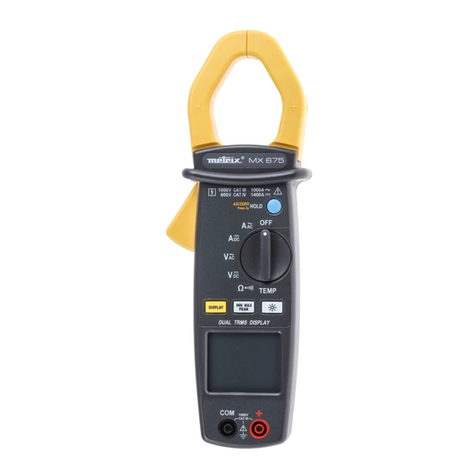
Metrix
Metrix MX 670 User manual
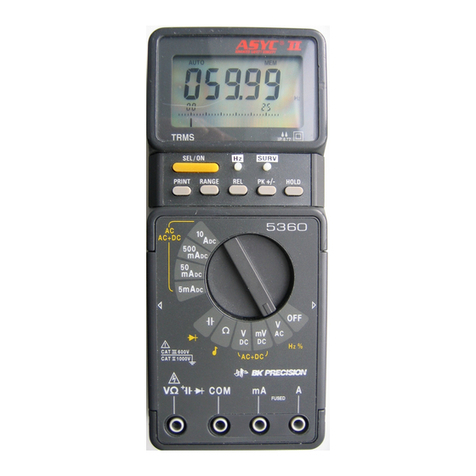
Metrix
Metrix MX 56C User manual
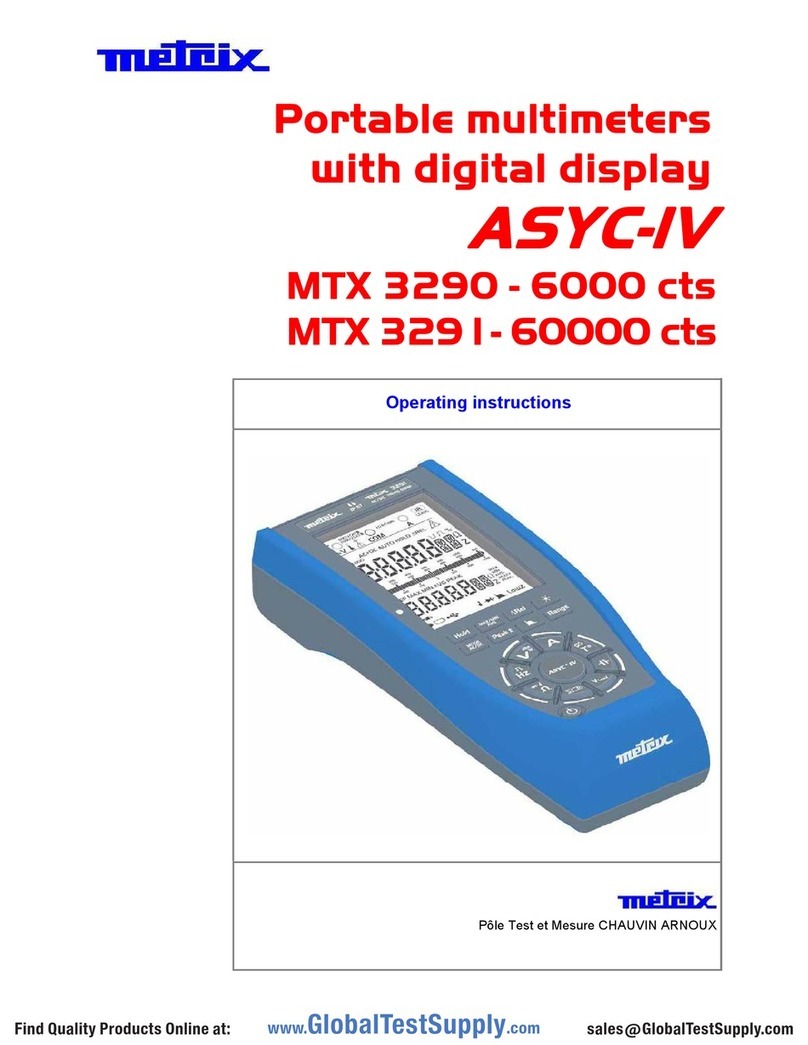
Metrix
Metrix ASYC-IV User manual
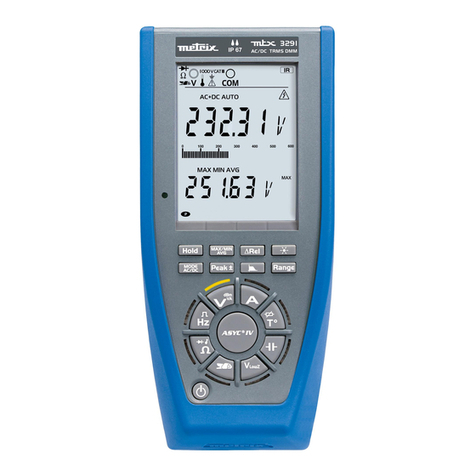
Metrix
Metrix MTX 3290 User manual

Metrix
Metrix MX 59HD User manual
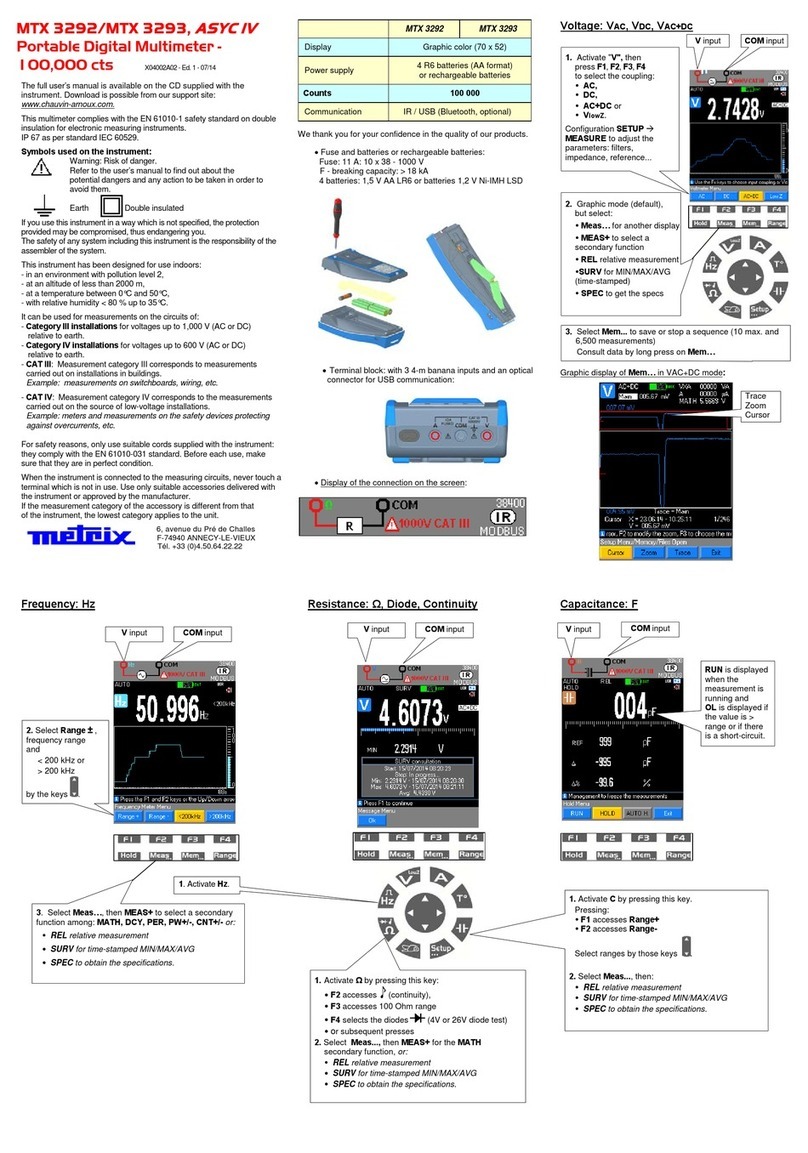
Metrix
Metrix MTX 3292 User manual
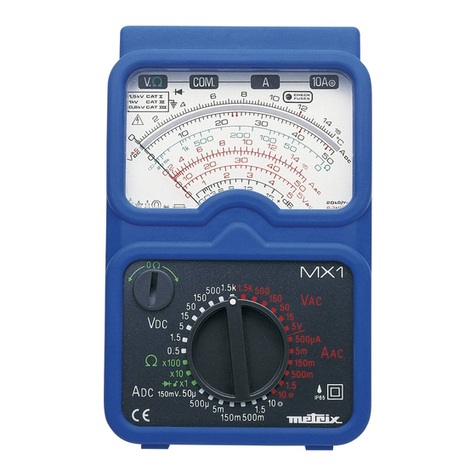
Metrix
Metrix MX 1 User manual
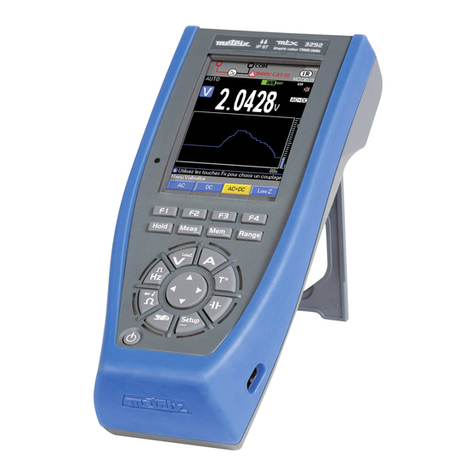
Metrix
Metrix ASYC IV MTX 3292 User manual
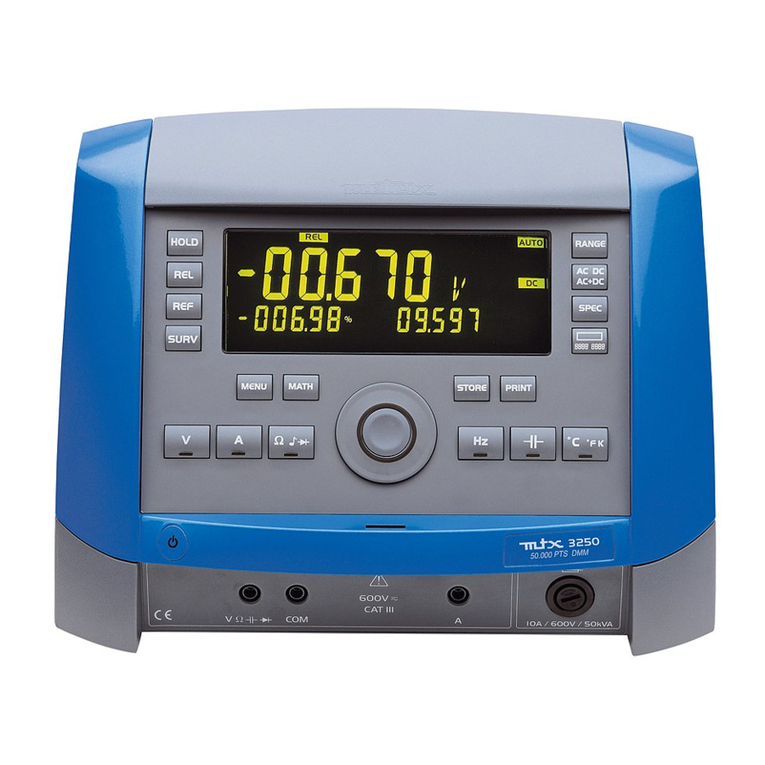
Metrix
Metrix MTX 3250 User manual
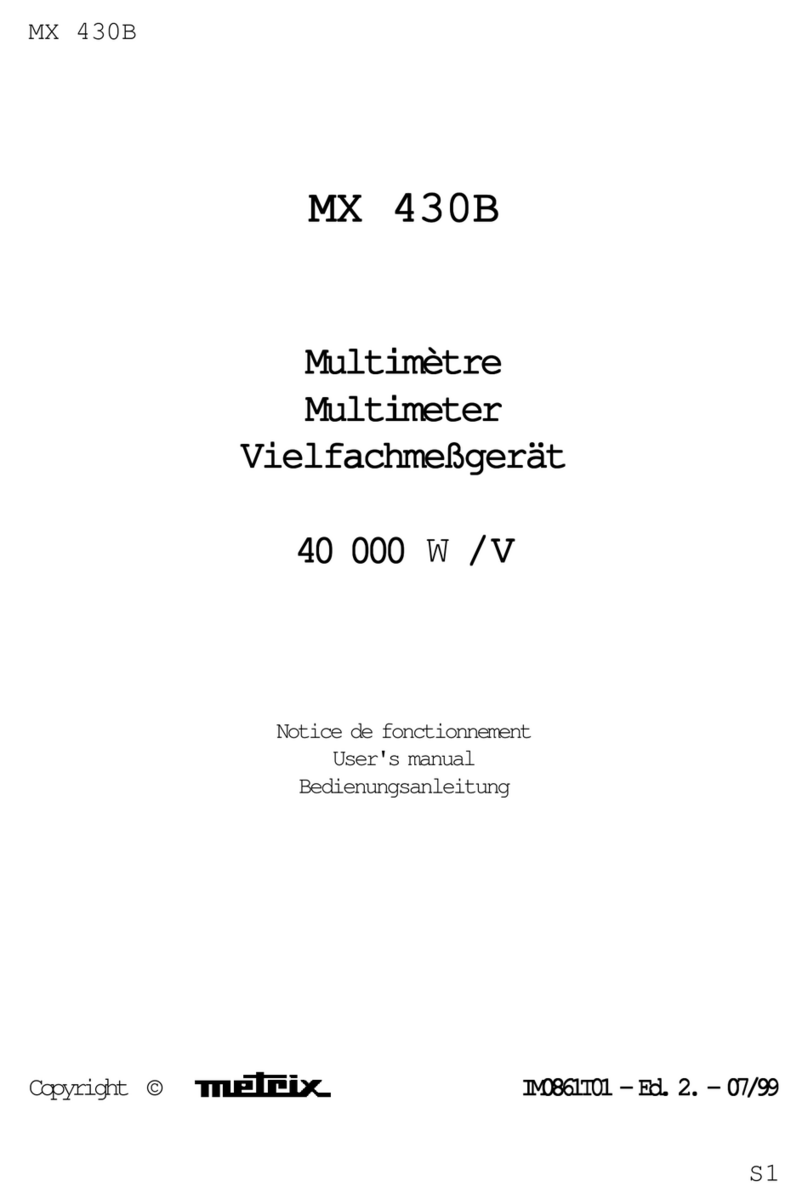
Metrix
Metrix MX 430B User manual
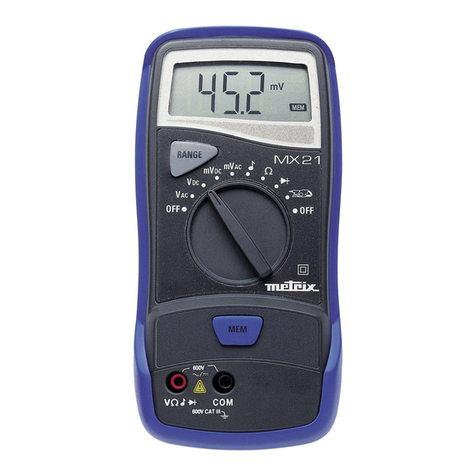
Metrix
Metrix MX 21 User manual
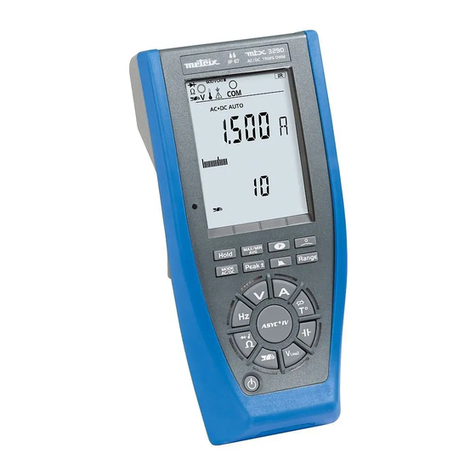
Metrix
Metrix ASYC-IV User manual

Metrix
Metrix MX 21 User manual
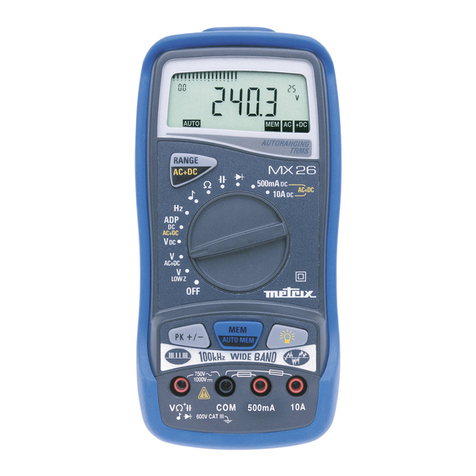
Metrix
Metrix MX 26 User manual

Metrix
Metrix MX 1 User manual
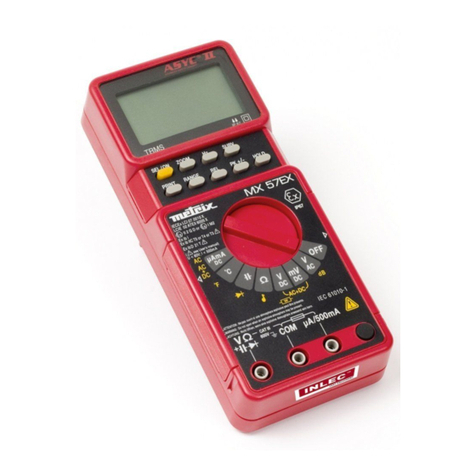
Metrix
Metrix MX 57 EX User manual

Metrix
Metrix MX 1 User manual

Metrix
Metrix MX 26 User manual
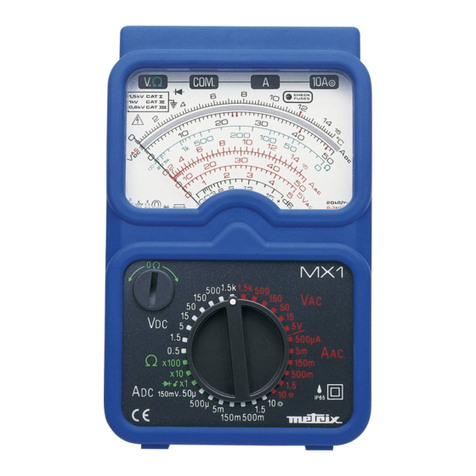
Metrix
Metrix MX 1 User manual
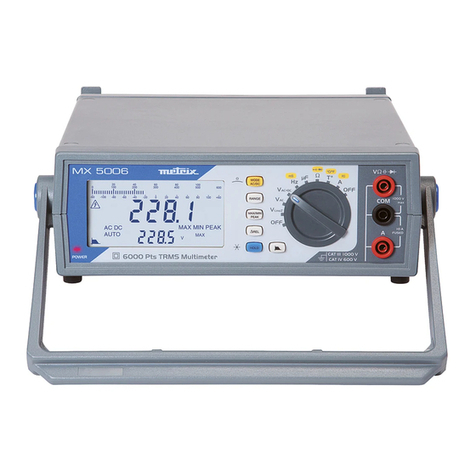
Metrix
Metrix MX 5060 User manual


